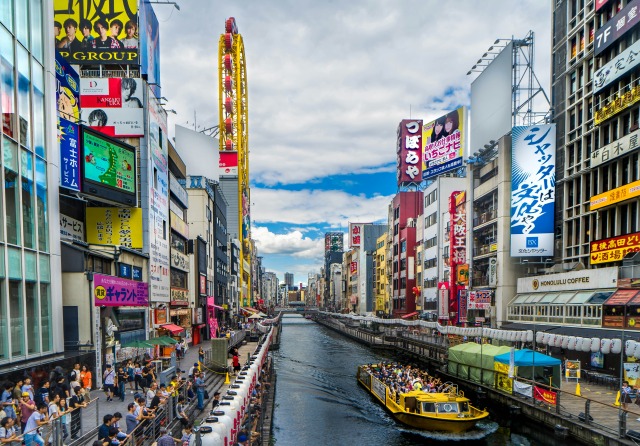What Makes Real Estate Investment in Osaka So Attractive? A Comparison with Tokyo!
2025-04-29
Real Estate Investment in Japan

Osaka, the center of the Kansai region and the second largest city after Tokyo, is a highly popular area for real estate investment.
In recent years, attention toward Osaka has been increasing, especially due to the surge in Tokyo property prices, the upcoming Expo, and the attraction of an Integrated Resort (IR) project.
In this article, we will clearly explain the appeal of real estate investment in Osaka, its points of caution, and recommended areas while comparing it with Tokyo.
Here are investment properties in Osaka.
At wagaya Japan, our agents who are well-versed in the Osaka real estate market
provide full support for your investment.
Comparison between Osaka and Tokyo
Both Osaka and Tokyo are popular investment destinations, but they have different characteristics and market trends.
First, let’s take a look at how Osaka and Tokyo compare.
Real Estate Prices
According to the Ministry of Land, Infrastructure, Transport and Tourism’s Real Estate Price Index (with 2010 as the base year at 100), the figures for Tokyo and Osaka are as follows:
| Year/Area | Tokyo | Osaka |
|---|---|---|
| Dec 2021 | 139.1 | 127.5 |
| Dec 2022 | 153.7 | 141.4 |
| Dec 2023 | 158.1 | 142.3 |
| Dec 2024 | 170.9 | 149.6 |
Both cities are experiencing price increases, but the growth rate is particularly higher in Tokyo.
Additionally, based on the 2023 transaction prices by property type reported by East Japan and Kinki Real Estate Information Networks:
| Property Type | Tokyo (million yen) | Osaka (million yen) |
|---|---|---|
| Pre-owned Condominium | 56.78 | 30.52 |
| Pre-owned House | 53.38 | 22.26 |
| Newly Built House | 50.65 | 34.33 |
| Land | 58.43 | 29.46 |
Depending on the property type, Osaka’s prices are about 60–70% of Tokyo’s.
This makes it easier to invest in Osaka with a lower initial cost.
Population Trends
Population trends are also crucial for real estate investment.
Areas with a growing population are expected to maintain stable rental demand.
According to the National Institute of Population and Social Security Research, future population trends are as follows:
| Year | Tokyo Population | Osaka Population |
|---|---|---|
| 2020 | 14,047,594 | 8,837,685 |
| 2025 | 14,198,914 | 8,676,202 |
| 2030 | 14,348,591 | 8,437,625 |
| 2050 | 14,399,144 | 7,263,182 |
Tokyo’s population is increasing.However, the survey shows that except for Tokyo, all other prefectures (including Osaka) are experiencing population declines by 2025.
Nevertheless, according to the 2020 census, Tokyo accounts for 11.1% of Japan’s total population, followed by Kanagawa (7.3%) and Osaka (7.0%).
Although Osaka’s population is declining, it remains one of the most populous cities in Japan.
Inbound Demand
In 2023, Tokyo welcomed 19.54 million international visitors, a 28.7% increase compared to the pre-COVID year of 2019.

Meanwhile, Osaka had 9.798 million visitors in 2023 (85% of 2019 levels).
However, per capita spending was 94,000 yen, a 131% increase compared to 2019, indicating growing inbound demand.
Moreover, in 2024, Osaka attracted approximately 14.64 million international visitors, up 47% from 2023, setting a new record.
According to the Japan National Tourism Organization, Osaka ranked second among prefectures visited by foreign tourists in 2023, with a 39.6% share after Tokyo’s 52.9%.
Given these trends, Tokyo and Osaka continue to show strong inbound demand, which is likely to increase further.
The Appeal of Real Estate Investment in Osaka
The key attractions of investing in Osaka’s real estate include:
Lower property prices than Tokyo
Promising future with the Expo and linear railway developments
Increasing number of households
Stable employment due to many large companies
Lower Property Prices Than Tokyo
As mentioned earlier, property prices in Osaka are about 60–70% of those in Tokyo.
This makes initial investments more affordable and leads to potentially higher yields.
With the same budget, you can acquire better-located or newer properties in Osaka compared to Tokyo.
Despite the lower prices, real estate indices show an upward trend, suggesting potential for capital gains depending on the property and area.
Promising Future with Expo and Linear Railway Projects
The 2025 Osaka-Kansai Expo, the 2030 IR project, and the linear railway project after 2034 are major upcoming events.
These events are expected to significantly boost the economy, raise property values, and increase rental demand.
Moreover, extensive redevelopment projects like the “Osaka Seven Major Regeneration Projects” around Osaka Station, Nakanoshima, Midosuji, and Namba are underway, likely driving up land and property prices.
Thus, Osaka’s active development makes it a promising choice for long-term real estate investment.
Increasing Number of Households
According to Osaka Prefecture, the number of households reached about 4.309 million in 2024, up from approximately 4.253 million in 2023.
Despite a decreasing population, the “social increase” (more people moving in than moving out) is positive.
This trend suggests stable rental demand, supporting the potential for future investment.
Stable Employment with Many Large Companies
According to the Nikkei Shikiho, Osaka hosts 428 listed companies, ranking second after Tokyo.
Additionally, about 10% of Japan’s large companies (966 out of 10,363) are located in Osaka.
Although not as many as Tokyo, Osaka’s many large corporations ensure stable employment and generate strong rental demand.
At wagaya Japan, our agents who are well-versed in the Osaka real estate market
provide full support for your investment.
Points of Caution When Investing in Osaka

While Osaka offers many advantages, there are a few things to watch out for:
Rent levels are lower than in Tokyo
Careful area selection is crucial
Rent Levels are Lower Than in Tokyo
The average rent in Tokyo and Osaka is as follows:
| Type | Tokyo (yen) | Osaka (yen) |
|---|---|---|
| Single occupant | 69,202 | 54,836 |
| Family | 92,875 | 73,581 |
Rents are generally lower in Osaka, which can affect rental income.
However, due to lower property prices, investors can still aim for high yields.
Need to Carefully Select the Area
Not all areas in Osaka are equally profitable for investment.
Each area has distinct characteristics, so selecting the right area and strategy is essential.
Without proper understanding of local needs and conditions, profitability might suffer.
It is highly recommended to consult experienced local professionals when selecting an investment area.
Recommended Areas for Real Estate Investment in Osaka
If you are considering investing in Osaka, pay attention to the following areas:
Kita Ward
Chuo Ward
Yodogawa Ward
Kita Ward is home to major stations like Umeda and Osaka Stations, and is a hub for business and commerce.
The ongoing “Umekita Project” redevelopment is expected to further boost land values and rental demand.
Chuo Ward is the administrative, economic, and financial center of Osaka.
Though residential areas are limited, the high demand for proximity to workplaces and the construction of high-rise condominiums keep rental demand strong.
Yodogawa Ward houses Shin-Osaka Station, offering excellent transport access and hosting many major corporations.
Future projects like the Linear Railway and the extension of the Hokuriku Shinkansen are expected to further raise property values.
Conclusion
Osaka offers more affordable property prices compared to Tokyo, enabling investors to expect higher yields.
With future prospects such as the Expo, IR projects, and major redevelopments, Osaka is certainly worth considering as an investment destination.
However, strategies should vary depending on the specific area, so it is important to consult local experts when making investment decisions.
Here are investment properties in Osaka.
At wagaya Japan, our agents who are well-versed in the Osaka real estate market
provide full support for your investment.

